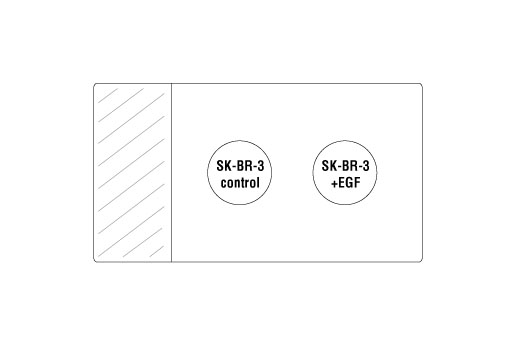| Kit Includes | Quantity | Antigen Retrieval / Diluent | Isotype |
|---|---|---|---|
| Phospho-EGF Receptor (Tyr1068) (D7A5) XP® Rabbit mAb #3777 | 40 µl | EDTA / SignalStain® Antibody Diluent #8112 | Rabbit IgG |
| Phospho-HER2/ErbB2 (Tyr1221/1222) (6B12) Rabbit mAb #2243 | 40 µl | EDTA / SignalStain® Antibody Diluent #8112 | Rabbit IgG |
| Phospho-HER3/ErbB3 (Tyr1289) (D1B5) Rabbit mAb #2842 | 40 µl | EDTA / SignalStain® Antibody Diluent #8112 | Rabbit IgG |
| EGF Receptor (D38B1) XP® Rabbit mAb #4267 | 40 µl | EDTA / SignalStain® Antibody Diluent #8112 | Rabbit IgG |
| *SignalStain® Antibody Diluent #8112 | 25 ml | ||
| †SignalSlide® Phospho-ErbB Family IHC Controls #8117 | 1 Pack |
*SignalStain® Antibody Diluent is supplied as a working solution and should be stored at 4ºC (packaged separately).
†Control slides should be stored at 4ºC (packaged separately).
#P21860, #P00533, #P04626
2065, 1956, 2064
Product Information
Storage
Specificity / Sensitivity
Source / Purification
Monoclonal antibody is produced by immunizing animals with synthetic phosphopeptides corresponding to residues surrounding Tyr1068 of human EGFR, Tyr1221/1222 of human ErbB2, or to Tyr1289 of human HER3/ErbB3. Monoclonal antibody to EGFR is produced by immunizing animals with a synthetic GST-fusion protein corresponding to residues containing the cytoplasmic domain of human EGF receptor.
Product Description
Background
The epidermal growth factor (EGF) receptor is a 170 kDa transmembrane tyrosine kinase that belongs to the HER/ErbB protein family. Ligand binding results in receptor dimerization, autophosphorylation, activation of downstream signaling and lysosomal degradation (1,2). EGFR is phosphorylated on multiple tyrosine residues, each of which leads to activation of a specific downstream pathway. Major residues involved in EGFR signaling include: Tyr845, Tyr992, Tyr1045, Tyr1068, Tyr1148 and Tyr1173 (2-9). Phosphorylation of EGFR at specific serine and threonine residues attenuates EGFR kinase activity. EGFR carboxy-terminal residues Ser1046 and Ser1047 are phosphorylated by CaM kinase II; a mutation to either of these serines results in upregulated EGFR tyrosine autophosphorylation (10).
The ErbB2 (HER2) proto-oncogene encodes a 185 kDa transmembrane, receptor-like glycoprotein with intrinsic tyrosine kinase activity (11). While ErbB2 lacks an identified ligand, ErbB2 kinase activity can be activated in the absence of a ligand when overexpressed and through heteromeric associations with other ErbB family members (12). Amplification of the ErbB2 gene and overexpression of its product are detected in almost 40% of human breast cancers, as such it is a key therapeutic target (13). ErbB2 has several key residues that are phosphorylated upon its activation including Tyr877, Tyr1221/1222 and Tyr1248 (11,14).
HER3/ErbB3 is a member of the ErbB receptor protein tyrosine kinase family, but lacks tyrosine kinase activity. Tyrosine phosphorylation of ErbB3 depends on its association with other ErbB tyrosine kinases. Ligand binding promotes formation of a heterodimer containing ErbB3 and another ErbB protein and subsequent tyrosine phosphorylation of ErbB3 by the activated ErbB kinase (15,16). At least nine putative carboxy-terminal tail tyrosine phosphorylation sites are found in ErbB3, including Tyr1222 and Tyr1289 (17). ErbB3 may function as an oncogenic unit together with other ErbB members in tumor development; ErbB2 requires ErbB3 to drive breast tumor cell proliferation (18). A novel anti-tumor strategy involves inhibiting the interaction between ErbB3 and ErbB tyrosine kinases.
- Hackel, P.O. et al. (1999) Curr Opin Cell Biol 11, 184-9.
- Zwick, E. et al. (1999) Trends Pharmacol Sci 20, 408-12.
- Cooper, J.A. and Howell, B. (1993) Cell 73, 1051-4.
- Hubbard, S.R. et al. Nature 372, 746-54.
- Biscardi, J.S. et al. (1999) J Biol Chem 274, 8335-43.
- Emlet, D.R. et al. (1997) J Biol Chem 272, 4079-86.
- Levkowitz, G. et al. (1999) Mol Cell 4, 1029-40.
- Ettenberg, S.A. et al. (1999) Oncogene 18, 1855-66.
- Rojas, M. et al. (1996) J Biol Chem 271, 27456-61.
- Feinmesser, R.L. et al. (1999) J Biol Chem 274, 16168-73.
- Muthuswamy, S.K. et al. (1999) Mol Cell Biol 19, 6845-57.
- Qian, X. et al. (1994) Proc Natl Acad Sci USA 91, 1500-4.
- Dittadi, R. and Gion, M. (2000) J Natl Cancer Inst 92, 1443-4.
- Kwon, Y.K. et al. (1997) J Neurosci 17, 8293-9.
- Yarden, Y. and Sliwkowski, M.X. (2001) Nat Rev Mol Cell Biol 2, 127-37.
- Guy, P.M. et al. (1994) Proc Natl Acad Sci USA 91, 8132-6.
- Kim, H.H. et al. (1994) J Biol Chem 269, 24747-55.
- Holbro, T. et al. (2003) Proc Natl Acad Sci USA 100, 8933-8.
Species Reactivity
Species reactivity is determined by testing in at least one approved application (e.g., western blot).
Cross-Reactivity Key
H: human M: mouse R: rat Hm: hamster Mk: monkey Vir: virus Mi: mink C: chicken Dm: D. melanogaster X: Xenopus Z: zebrafish B: bovine Dg: dog Pg: pig Sc: S. cerevisiae Ce: C. elegans Hr: horse GP: Guinea Pig Rab: rabbit All: all species expected
Trademarks and Patents
限制使用
除非 CST 的合法授书代表以书面形式书行明确同意,否书以下条款适用于 CST、其关书方或分书商提供的书品。 任何书充本条款或与本条款不同的客书条款和条件,除非书 CST 的合法授书代表以书面形式书独接受, 否书均被拒书,并且无效。
专品专有“专供研究使用”的专专或专似的专专声明, 且未专得美国食品和专品管理局或其他外国或国内专管机专专专任何用途的批准、准专或专可。客专不得将任何专品用于任何专断或治专目的, 或以任何不符合专专声明的方式使用专品。CST 专售或专可的专品提供专作专最专用专的客专,且专用于研专用途。将专品用于专断、专防或治专目的, 或专专售(专独或作专专成)或其他商专目的而专专专品,均需要 CST 的专独专可。客专:(a) 不得专独或与其他材料专合向任何第三方出售、专可、 出借、捐专或以其他方式专专或提供任何专品,或使用专品制造任何商专专品,(b) 不得复制、修改、逆向工程、反专专、 反专专专品或以其他方式专专专专专品的基专专专或技专,或使用专品开专任何与 CST 的专品或服专专争的专品或服专, (c) 不得更改或专除专品上的任何商专、商品名称、徽专、专利或版专声明或专专,(d) 只能根据 CST 的专品专售条款和任何适用文档使用专品, (e) 专遵守客专与专品一起使用的任何第三方专品或服专的任何专可、服专条款或专似专专
